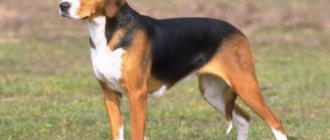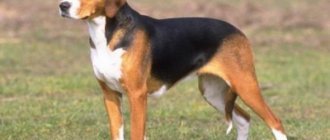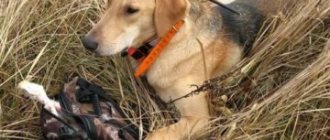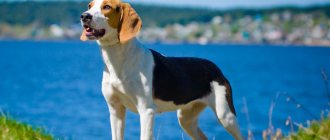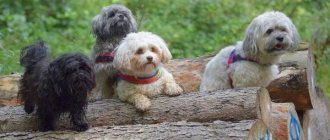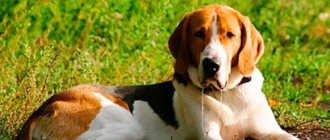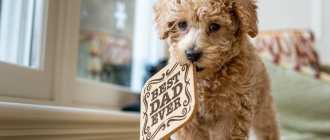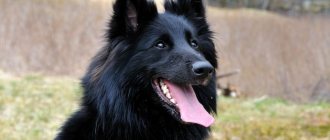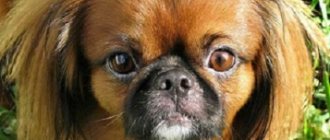Hunting was traditionally considered the favorite pastime of the Russian nobility, and hounds were the main characters in it.
Even then, the character traits and skills inherent in hunting breeds were valued.
Thus, for several centuries, the Russian hound has been considered the best hunting assistant and is dearly loved by Russian hunters .
History of the Russian hound breed
The Russian hound is a breed of dog that has been actively used in hunting foxes and other fur-bearing animals since ancient times. There is no exact information about how dogs of this breed appeared on the territory of the Russian Federation. It is believed that the Tatar-Mongol tribes took them with them. But there is another version put forward by the author of many books on dog breeding, A.V. Kamernitsky. It lies in the fact that the Russian hound was obtained as a result of crossing abiogenic huskies and pointers brought to the territory of Russia.
Our ancestors began using Russian hounds as hunting dogs at the beginning of the twelfth century, and in the nineteenth they were already actively shown at exhibitions. But at that time they were called “eastern hounds”.
Photo of a Russian hound
At the beginning of the twentieth century, targeted work began on the breed, and the phenotype was practically formed. But the civil war prevented it from being perfected. While it lasted, work on the breed stopped. At the end of the war, we had to restore the number of dogs and start all over again.
The process was greatly slowed down by the presence of a large number of diverse domestic livestock. Tsarist Russia could boast of considerable kennels in which dogs were kept after the revolution. In 1925, at the All-Union Congress of Cynologists, it was possible to adopt a specific and separate standard for the Russian hound. This allowed the breed to stand out among many other similar dogs. And in 1939, a law was issued that prohibited the breeding of any type of hounds other than Russian and Anglo-Russian.
In 1901, the first tests to identify the working qualities of the breed appeared. They were aimed not at specific individuals and their talents, but at the ability of dogs to work in groups. And only twenty-five years later a special complex was developed that made it possible to select Russian hounds according to individual characteristics.
Historical reference
The first notes about Russian hounds appear in the 12th century, however, a description of the breed and mention of hunting with them appears only at the very end of the 18th century. From this moment the official international history of these animals begins.
In every noble estate there were large packs of these dogs, however, no one monitored the purity of the breed, and the dogs were bred based on the preferences of their owners.
The creation of the domestic hound type began only in 1874 during the first exhibition of hunting dogs.
The initial breed standards appeared in 1881, and in 1895 the official name changed to “Russian Hound”.
A surge in interest in the breed occurred after the October Revolution of 1917, after which a breed of Russian hounds was created with a legendary musical voice and resilience (endurance, vitality).
Description of the Russian hound breed
These strong dogs are characterized by height above average, have an elongated body and a special “animal” appearance, which can externally resemble a wolf. This appearance is due to the high frontality and characteristic manner of keeping the head low.
Head
Head. Dry, wedge-shaped. Quite strong, proportional to the body. The occipital protuberance and brow ridges are weakly expressed.
Muzzle. Elongated, the transition of the forehead to the muzzle is smooth, but very clearly visible.
Ears. They are shaped like a triangle and are in a hanging position. Relative to the head, they are not very large, they fit well to the skull.
Nose. The nose is black, quite large and wide. Protrudes forward a little.
Mouth. Jaws with well-developed muscles, strong.
Teeth. They have a scissor bite. The dentition is smooth and clear, stands out well.
Lips. Narrow and dry, fits well to the jaws and teeth. Darker than the overall tone.
Eyes. Almond-shaped, stand slightly slanted. The iris of the Russian Hound is a rich brown color.
Neck. The length of the neck is the same as the length of the entire head. Well muscled, stands low.
Frame
Frame. Strong, with developed and dry muscles. The withers are clearly visible and are located above the level of the back. The top point of the croup is one to two centimeters lower than the same point of the withers. The back of the Russian Hound is also well muscled, characterized by a slight elevation above the top line in the shape of a dome. The croup is rounded and slightly sloping. The belly is dry and lean.
Breast. Quite wide, set deep. The lowest point of the chest is located below the elbow joints.
Tail. Thickened at the base, tapering towards the end. Does not fall below the hock joint even when at rest. When the dog is alert, it rises to the level of the back line. Incorrect shape or too long length will be grounds for disqualification.
Limbs
Front. If you look at the dog from the front, the paws will be parallel to each other and stand perpendicular to the surface. The muscles are well defined and dry. The elbows are parallel, “looking” straight back. The degree of the scapulohumeral angle of the Russian hound is slightly above one hundred. The pasterns are quite strong, the toes are pressed tightly together, and are dark in color.
Rear. The hind legs are also dry and well muscled. The angle of the hock joint is well defined. The shins have an elongated shape.
Wool
The Russian hound has a medium-length coat and is only significantly shorter on the limbs and ears. It forms a noticeable scruff around the neck. The undercoat is dense and dense.
Colors
According to the standard, the Russian hound can have only three colors:
- gray and tan;
- black-and-white;
- scarlet.
The tan marks, in turn, can be white or slightly yellowish. Small spots are allowed in the neck area.
Character
Russian hounds are distinguished by their extraordinary intelligence, endurance, tolerance and balanced character. They are calm and will not “go broke” without a reason. They interact well with all family members, but they always choose only one owner, whom they obey unquestioningly and consider as an authority.
The Russian hound has very highly developed hunting instincts. Therefore, it may be difficult for her to get along with other pets, especially if they are rodents. On the street, a dog can “encroach” on the lives of cats and birds, as well as small “brothers”. Therefore, it is very important to raise your dog correctly from an early age to avoid possible problems in the future.
Russian hounds treat children very well. They love to play active sports with older children and will calmly endure the hugs of babies. They can become a wonderful and sensitive nanny.
A high level of intelligence allows dogs to learn quickly. They literally pick up commands on the fly, training will not be a burden. But it must be carried out systematically; a special approach must be found to the Russian hound. This dog can show not only positive aspects of its character, but also not the most pleasant ones from the point of view of its owners. These are stubbornness, willfulness and dominance. The owner needs to show strength of character and perseverance.
In general, the Russian Hound is a fairly balanced dog with a stable psyche. Its advantages also include unobtrusiveness. This breed will not pester the owner and require increased attention to itself.
Socialization
From the age of three months you can start raising a puppy. It is very important to instill qualities such as courage. Communication with peers is a fundamental point: sitting alone, the puppy will never learn to defend himself.
A basic training course will help you get used to other people. Special training programs, specifically for hunting dogs, will lay the foundations of hunting skills: not to be afraid of barking, loud sounds of a shot and a hunting horn, to be able to correctly grab game.
If there is a small child in the family, you need to carefully monitor how he communicates with his four-legged friend. A puppy, sensing a threat from a small person, may bark and even bite in self-defense. A puppy that grows up with a child will be more loyal to him.
Education and training
The intellectual indicators of this breed are at a high level, so training will be quick and effective. The dog remembers commands well and subtly senses the owner’s mood. There are even legends that the Russian hound “merges” so much with its owner. They say that during the hunt, these dogs are able to think the same way as their owners, literally capturing their train of thought, which allows them to achieve any goal.
But there is another side to the coin. Every Russian hound has a stubborn “dominant” inside it, which can wake up at any moment. This can play a cruel joke on the dog during training or work, despite the fact that Russian hounds are workaholics by nature.
For good health, animals need high physical activity. If you give your dog plenty of exercise before training, the results will be much better. If you start training before she can splash out her energy, then the Russian hound’s attention will be scattered, the dog will be nervous and restless.
Since the main purpose of the breed is hunting, the dog should be trained for it from the age of three months. From childhood, the Russian hound must get used to the sound of the hunting horn, and also learn the basics of this matter. It is recommended to lock the puppy in the room before feeding and blow the horn. Then, over time, the dog will understand the connection between this sound and receiving food. Therefore, it will immediately respond to the bugle during the hunt.
Photos of Russian hound training
It is important not only to develop the working qualities of the Russian hound, but also to restrain its natural instincts. Self-control is very often a weak point in this breed, so during the training process you need to emphasize it as well as politeness. In ordinary life, you should not indulge your pet. Don't let him pounce on the food as soon as the bowl touches the floor. The dog should get used to eating only when you allow it. You shouldn’t aggressively pull her away from the bowl, much less punish her physically. But simple persuasion will not solve the problem. This aspect is very important if you want to keep a dog not only “for beauty”, but also use it as a hunting partner.
To train the Russian hound, old and proven methods are used. A dog can be taken into the forest no earlier than it is one year old. Until this time, the puppies will bring little benefit and, to a greater extent, will simply have fun. It is better to start lessons early in the morning along the black trail, while the animal’s trail is still clearly visible and it is easy for the dog to pick it up. Dogs that will be used in pack hunting must be immediately accustomed to working in a paired collar, which is called a “bow.” An adult and experienced dog will be the best companion for a beginner. He will quickly learn all the wisdom from her if they are paired up.
Before you begin professional training of your dog, you must teach him standard commands, which include:
- "It is forbidden!";
- "To me!";
- "Stand!";
- "Drop it!" and etc.
A dog can chase an animal only if the owner has given the appropriate command. A dog that does not understand commands and does not obey its owner will be forced to make decisions on its own. This, as practice shows, leads to sad consequences. Untrained animals without proper skills rarely return from the forest.
The Russian Hound should be trained to react calmly to livestock and pets. This is quite difficult to do, so only patience and consistent training will help. You must always be on guard with this breed if it lives near a chicken coop or animal pen. Even those dogs that show their restraint can “break loose” and start hunting. Especially dangerous are those who have already tasted domestic duck or goose.
When hunting, the Russian hound has important tasks. She needs to not only take the trail of the animal and track it, but also intimidate it and force it to move towards the owner so that he can better aim before shooting. Also, the Russian hound is capable of giving signals with its barks about what kind of prey it managed to track down. To do this, dogs can change the timbre and pitch of their barking. By the way, the Russian hound's sound is unusually melodic.
A distinctive quality of this breed, which is highly valued by professional hunters, is its calliness. This means that the dog instantly responds to the call of its owner.
The ability to get through even dense thickets and thickets and endurance are no less highly valued. For example, a well-trained dog can chase a hare all day, taking only short breaks. The advantage of the Russian hound is considered to be its anger towards animals. If at home your pet is a meek and obedient animal, wagging its tail, then during the hunt a true and merciless predator will “awaken” in it. But, a balance must be maintained. The dog must remain controlled and not lose its head when it hears a fox or hare nearby. Twitching, nervousness and fussiness may indicate that the dog lacks the “correct” working qualities.
Most often, Russian hounds are used to hunt small animals, but some dogs are capable of driving down a wild boar or even a deer. There are two types of hunting for which this breed is used:
- The first option is motionless. In this case, the hunter stands in the best place for aiming and shooting, waiting for the dog to start chasing the animal towards him;
- The second option is the chassis. During this hunt, both move: the dog and the hunter himself.
If the dog is still young and has not gained experience, then it is preferable to practice the second option. In this way, the hunter can control the dog and guide it, correcting possible mistakes.
Some Russian hounds, despite their calliness, may have problems returning to their owner. A dog can get so carried away by the beast and the pursuit that it stops hearing the sound of the bugle and gets lost in the thicket of the forest. After some time, the dog can return, finding its way in its own tracks. That is why hunters are not recommended to leave the place where the dog was allegedly lost for at least a couple of hours. Modern technology makes it possible to search for animals more efficiently; some hunters use collars with a GPS function.
Hurry up, choose a box and find out what gift awaits you
Discount on pet insurance
Promo code copied to clipboard
Application
It is recommended to purchase a gonchak solely for the purpose of hunting. This dog is not suitable as a pet. The hunter's instincts are quite strong. The inability to use them will depress the dog and contribute to a change in character. A dog can run away from its owner during a walk.
During the hunt, the animal realizes its potential. This is his native element. The dog senses game well and is able to track it for a very long time without getting tired. Properly trained Russian piebald hounds will be able to drive the animal as close as possible to the hunter. After the shot, the dog will find and bring the prey.
Hounds are capable of chasing any animal, even such a large one as a wild boar or a wolf. But it’s best to track small animals: hares, foxes.
Racers never say “bitch” or “male”, “boy” or “girl”. There is a “vyzhlovka” and there is a “vyzhlovka”.
Maintenance and care
All their lives, no one pampered Russian hounds with “greenhouse conditions”. On the contrary, they were kept as "Spartans". Almost all of their time they spent in the fresh air. Dogs were brought into the kennel, which was not heated anyway, only in severe frosts. Modern breeders also have the opinion that warm rooms can negatively affect the working qualities of the Russian hound. They claim that dogs turn from tough hunters into sissies. Therefore, an excellent option for keeping a Russian hound would be a booth that is made of boards and insulated inside. A curtain to block the cold wind wouldn't hurt either. Dry leaves or grass are suitable for bedding.
It is better to place the booth not in the open air, but to protect it from snow and rain with a canopy, and also place an aviary (the size should not be less than 9 square meters). It is needed if the fence on the site is low or flimsy. If the fence is not strong enough, then the Russian hound will quickly deal with it: dig a hole or simply break it with its teeth and claws.
The dog can be kept in a kennel (shed), but it needs to be in the fresh air enough. With a lack of sunlight, some dogs develop rickets. Puppies and pregnant bitches, as a rule, are placed in separate enclosures.
It is better to cover the floor in the enclosure with sawdust. This will make cleaning much easier. The Russian Hound has a fairly tight coat, so sawdust will not interfere with the animal. It is recommended to pour gravel in one of the corners. Thanks to this technique, the dog’s fingertips will gradually become rougher, sensitivity will decrease, which will allow the Russian hound to move freely through the forest and not feel discomfort.
You need to walk a Russian hound not twice a day, like many other dogs, but at least three times. Physical activity is very important to her. Dogs that don't get their energy out can develop behavior problems. In addition, the dog will rapidly gain weight, which he definitely does not need for hunting.
Use a muzzle for walks. The Russian Hound is not a naturally aggressive, but rather large breed of dog. Therefore, it is better to play it safe so that others can be calmer. To make it easier to control your pet, use a short or long leash in different situations.
The Russian Hound's coat does not require special care. It is enough to bathe the animal once a month, and the rest of the time you can simply clean it with a wet mitten. Combing is also not necessary; the dog sheds quite heavily, but evenly. But if you occasionally run a brush over your dog’s body, he will look much neater.
It is better to bathe your dog in the summer so that it does not freeze in the winter when it dries in the open air. During the warmer months, Russian hounds can "shower" with shampoo designed specifically for dogs. And when it’s cold, you can “soap” the wool with clean snow. If the dog decides to swim in a lake or river, then after that it needs to be washed with running water.
Check your pet's ears regularly. The released wax should be removed with wipes moistened with veterinary lotion.
After each hunt, it is necessary to carefully examine the pads and toes of the Russian hound. In these places, dogs often have splinters that need to be removed, otherwise the wound will become inflamed. Damaged skin is treated with an antiseptic. Preferably for those who don't bake.
Many dogs of this breed are not averse to chewing branches or pine cones during their leisure time in the forest. Therefore, examining the mouth will also not be superfluous. Don't ignore your eyes.
Dogs that regularly go hunting should definitely be vaccinated against such a life-threatening disease as piroplasmosis. It is transmitted by the bite of ticks, of which there are a huge number in the spring and summer forests. Vaccination is carried out two to three months before the start of the hunting season. To provide additional protection, you can use sprays, drops or special collars that repel blood-sucking insects.
Nutrition
Russian hounds are quite picky eaters. They will be happy with anything you put in their bowl. Of course, each dog has its own preferences, as well as character or other characteristics. But they are definitely not picky when it comes to food.
Experienced breeders recommend feeding Russian hounds with professional premium and super premium wet or dry food.
If you decide to keep your pet on dry food, be sure to ensure that he has clean water available at all times. If the dog is not yet accustomed to the food, then give it in a soaked form. You can mix dry food with wet food. The main thing is that it is from the same manufacturer.
When choosing industrial food for your Russian hound, rely on the following tips:
- It should not contain too much phosphorus, as it negatively affects the dog’s nervous system;
- The percentage of protein for adult animals should not exceed 26%, and for puppies - 30%;
- For active dogs, the food should contain enough carbohydrates;
- Do not change food too often, introduce new ones gradually;
High quality food contains all the necessary vitamins and microelements and is well balanced. Therefore, there is no need to take additional supplements if your dog is completely healthy.
Health of the Russian Hound
The most important condition for maintaining the health of any breed of dog that is often in the fresh air and, especially, in the forest is timely vaccination and treatment for parasites.
Like all hunting dogs, the Russian hound can get rabies from a fox, which can carry this infectious disease. It is fatal for a dog, since no treatment has yet been invented. The only salvation is preventive vaccinations.
In addition to rabies, the Russian Hound has several diseases that this breed is susceptible to. These include hip dysplasia, as well as degenerative myelopathy. The former has become the most common disease in dogs over the past few decades. Many breeds suffer from it. There are special tests that can show the predisposition of a particular animal to hip dysplasia. Experienced breeders always ask to see the results of such tests before mating in order to protect future litters from hereditary diseases. A dog that suffers from dysplasia will be a cull. It cannot be used for hunting or breeding.
In degenerative myelopathy, the amount of white bone marrow gradually decreases. There is no treatment for this disease, only supportive therapy.
Russian hounds can injure their eyes on sharp branches or grass. Therefore, it is important to inspect them after every hunt.
This breed does not suffer from food allergies, so there is no need to select special food.
Males one year of age and older, as well as females after their second heat, are allowed for breeding. Matings are planned in such a way that they fall between hunting seasons. Pregnancy in a Russian hound lasts 56-63 days; bitches generally give birth easily. The first litter can have from two to four puppies, and then from four to six. Females have a pronounced maternal instinct; they do not leave their puppies and care for them, providing them with warmth, food and safety.
Diseases
The Russian Hound is a very healthy and hardy breed. Life expectancy can reach 12–14 years. The only genetic disease that can affect dogs is degenerative myelopathy.
The disease appears in dogs over 8 years of age. The cause of development is a mutation in one of the genes, leading to an amino acid substitution. The disease affects the dog's spinal cord, which is why it is called neurodegenerative. It is characterized by impaired function of motor neurons in the spinal cord due to degeneration of nerve endings. This leads to paralysis of the hind limbs.
It is impossible to cure the disease, but there is a genetic test that allows you to identify carriers and sick animals. Such individuals are not allowed for breeding.
Russian hounds do not suffer from many ailments
Photos of Russian hounds
Who are Russian hounds suitable for?
The Russian hound is ideal for a person who is keen on hunting and needs a loyal and intelligent animal that will help track and chase animals. You should not get this breed if you live in a small apartment. The dog requires constant walking and activity, even if it lives in a private house. She will hang out in the apartment. If you are not going to cultivate working skills in your Russian Hound and do not go out hunting, the dog will not be able to realize its potential. As a result, the animal may develop behavioral deviations.
A Russian hound will not be the best option if you have not had dogs before, and this pet will be the first. The Russian hound is somewhat willful and stubborn, so you may not calculate your strength and fail to cope with training. But she gets along well with children, provided that the dog receives proper upbringing from an adult family member.
Vaccinations
All vaccination activities are carried out in the same way as for any other purebred dogs, with the exception of animals that for some reason require an individual schedule.
On average, a dog receives its first vaccination after a month of life. Veterinarians recommend that such puppies be vaccinated against distemper and repeat the procedure at least 2 weeks later.
The third time - after replacing all the teeth with molars, approximately 6.5 months (the rabies vaccine is also administered). The vaccination is then repeated annually throughout the dog's life.
How to choose a puppy?
Choosing a puppy of any breed is a very responsible matter. After all, he will become a new member of your family. You should be especially careful when choosing a Russian hound if you plan to go hunting with it.
When choosing, it is better to be present in person, so visit the nursery to look at the babies, their mother and the conditions in which they are kept. Watch the dogs. They must be active and eat with appetite. Pay attention to the puppy's coat, it should be shiny and smooth.
The breeder must show you all the necessary documents, including the passports of the puppies' parents. When your new pet finds itself in a new place, you need to follow all the advice and instructions of the breeder so that the puppy successfully adapts.
For future hunters, the requirements are more stringent than for those dogs that will not be used for this. Take a closer look at the puppy's build; it should be large, with straight limbs, without a saggy belly or arched back. Of course, a lot depends on training, but health, pedigree and inclinations will play an important role in character formation.
Photos of Russian hound puppies
Price for Russian hounds
If you need a puppy without a pedigree, then you can buy it for around three to five thousand rubles. Such a dog can often be found not from breeders, but from hunters who keep Russian hounds. This mating produces beautiful puppies with working qualities from their parents. But, as a rule, their owners do not want to deal with paperwork. That's why they sell animals at such a low price.
If you need a puppy with a pedigree from famous parents, then the cost will increase three or even four times.
You can also buy an adult dog that has all the necessary skills for hunting. A dog that has already proven itself to be an excellent companion and has tracked down more than one hare, but without documents, will cost four to five thousand rubles. If the dog takes part not only in hunting, but also in exhibitions, and has diplomas, cups and medals, then it will cost from fifteen to thirty thousand rubles.
Mating
To select a suitable batch, contact kennel clubs. It is unacceptable to look for a partner based on an advertisement on the Internet or through friends. Only in the club can you get reliable information about the health and pedigree of the “groom” or “bride”.
The partner for mating must be “vocal,” that is, have a melodic, drawn-out, melodious bark, characteristic only of the Russian piebald hound breed.
The best age for a bitch to mate and bear offspring is from one and a half to six years. At this time, dogs are in full bloom. Earlier or later matings can provoke premature birth or the appearance of weak offspring.
At the time of mating, the bitch must be treated for fleas and helminths. It is better to double-check that you have all the necessary vaccinations. Only in this case can the mother provide the puppies with her immunity during the first 8 weeks of the babies’ lives. Mating is done in the morning; the animals are not fed. They are allowed to walk as much as possible. The bitch arrives in the dog's territory. They are given time to get to know each other. If it is a male dog's first mating, then he may need human help. The dogs are placed side by side and the male is helped to put his paws over his back. Control mating is carried out after one to two days.
